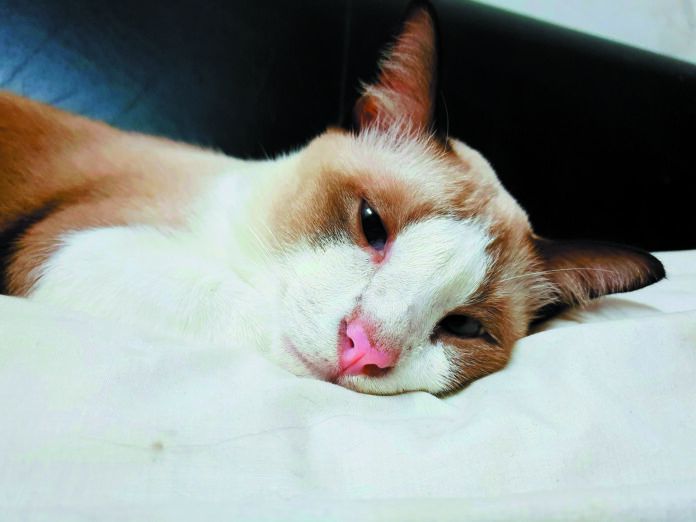Feline Infectious Peritonitis, or FIP, is caused by a coronavirus, although not the one that brings on Covid-19. The virus takes up residence in up to 40 percent of house cats and up to 100 percent of cats that live in large group situations, such as shelters. It is passed from cat to cat when shed in feces and saliva.
The virus on its own is relatively benign. In fact, most of the time it causes no symptoms whatsoever. Occasionally, after it gets inside a cat’s body and reaches the gastrointestinal tract, a cat will develop mild, transient diarrhea. A cat may also experience sneezing and watery eyes. But these issues resolve on their own.
The problem really starts when the virus mutates, which it is all too prone to do. It then leaves the intestinal tract and migrates to various organs and tissues, wreaking havoc and becoming deadly. The mutated FIP virus can cause fluid to build up in the abdominal or chest cavity (that’s the so-called wet form of the disease), and it can also cause systemic inflammation, meaning inflammation throughout the body (the “dry” form). Inflammation is particularly common in the liver, kidneys, intestines, and lymph nodes, and also in the eyes and nervous system. The dry form is somewhat less common than the wet form.
FIP mostly affects younger cats, with about 70 percent of cases diagnosed in felines less than one and half years old. Queens who have the benign form of the virus frequently pass it along to their very young kittens, and it mutates in them.
The difficulty of diagnosis
Diagnosis can be elusive, at least in the beginning, in no small part because the signs of FIP resemble the signs of so many other diseases. A cat may become lethargic and lose his appetite. He may also develop a fever. As the disease progresses, a cat could lose coordination because of the illness’s effect on the nervous system. If fluid accumulates in the abdomen, he may develop a pot belly. Cats who build up fluid in the chest cavity may have increased breathing difficulties.
FIP can develop a very long time after the relatively harmless coronavirus enters a cat’s body, so it’s not easy to trace. Making matters more difficult still is that there’s no specific test for FIP. Antibody levels (titers) to the coronavirus can be measured, but they do not prove a cat has the disease — only that he has had prior exposure to the unmutated virus, which so many cats have.
Instead, it’s a diagnosis of exclusion. If a cat, particularly a young cat, has a fever that doesn’t respond to antibiotics along with high coronavirus titers, a presumptive diagnosis of FIP may be made. A finding of fluid accumulation in the abdominal or chest cavity in addition to the other signs makes a diagnosis firmer.
There are some tests that get closer to identifying the problem than a measurement of antibodies. But at least one of them requires a biopsy, and none of them is 100 percent accurate. However the diagnosis is made, the disease is extremely difficult to treat and almost always ends in death. A cat’s immune system cannot successfully combat FIP, and no drug treatment for FIP has been approved by the Food and Drug Administration as of yet, making the prognosis for just about all cats pretty grim. That said, there’s some hope for a cure.
Treatment options on the horizon
Certain antiviral preparations (not yet approved by the FDA) have shown promise in vanquishing FIP in clinical trials. In fact, a trial conducted with an experimental drug at the University of California, Davis, even put one cat into remission. The cat, a kitten, had to take medication orally every day for three straight months, but it was a small price to pay. She is now thriving, when the alternative would have been death. In the meantime, researchers at Davis are also looking at antiviral drugs combined with stem cells. They are hoping the stem cells can enhance the immune response.
“FIP is a devastating disease,” says Tufts veterinary internist Michael Stone, DVM. “It is heartbreaking for people to stand by and watch their cat die. The new drugs being investigated on a number of different fronts provide great promise that FIP won’t always be a near-certain death sentence.”
© Dark Caramel | Bigstock
It can be hard to diagnose FIP. The signs are not specific to
that disease.




